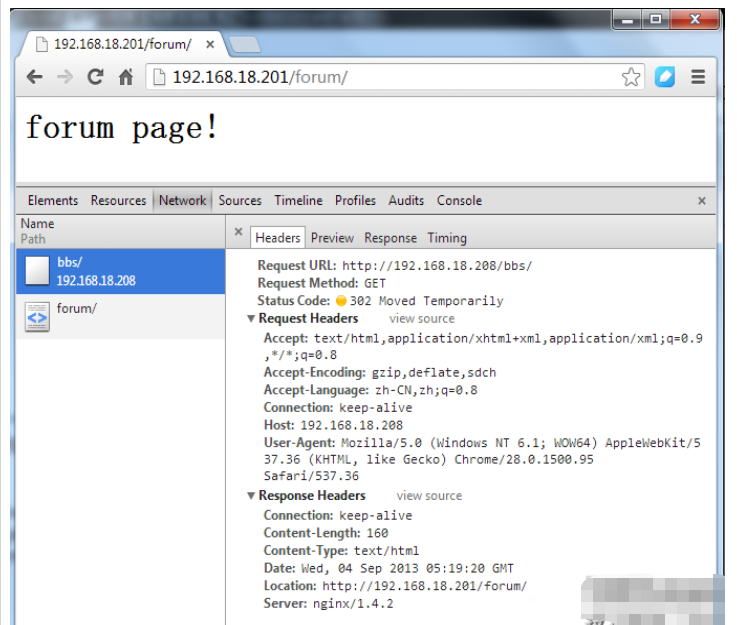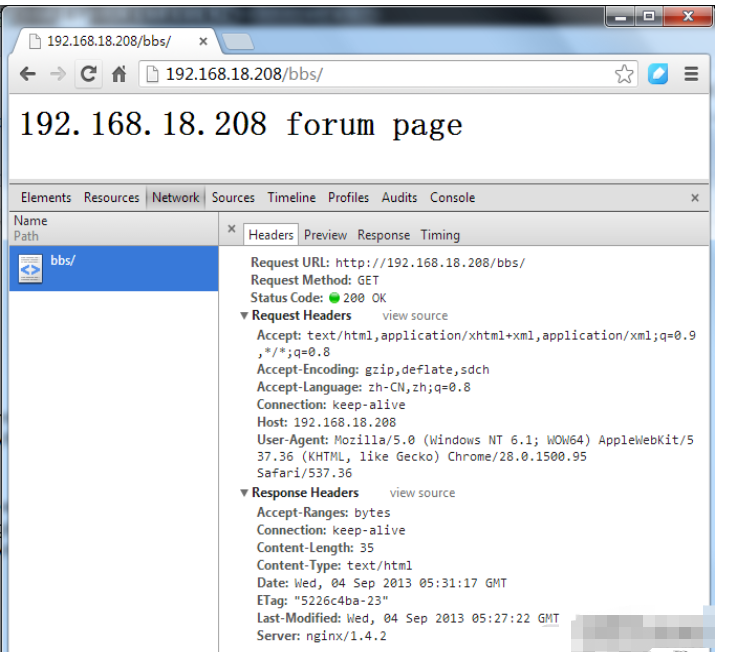nginx的url重写怎么用
nginx之url重写
1.url重写模块(rewrite)
摘要这个模块允许使用正则表达式重写uri(需pcre库),并且可以根据相关变量重定向和选择不同的配置。如果这个指令在server字段中指定,那么将在被请求的location确定之前执行,如果在指令执行后所选择的location中有其他的重写规则,那么它们也被执行。如果在location中执行这个指令产生了新的uri,那么location又一次确定了新的uri。这样的循环可以最多执行10次,超过以后nginx将返回500错误。
break
语法:break
默认值:none
使用字段:server, location, if
完成当前设置的规则,停止执行其他的重写指令。
示例:
if ($slow) {
limit_rate 10k;
break;
}if
语法:if (condition) { … }
默认值:none
使用字段:server, location
注意:在使用if指令之前请查看if is evil page并且尽量考虑用try_files代替。
判断一个条件,如果条件成立,则后面的大括号内的语句将执行,相关配置从上级继承。
可以在判断语句中指定下列值:
一个变量的名称;不成立的值为:空字符传”“或者一些用“0”开始的字符串。
一个使用=或者!=运算符的比较语句。
使用符号~*和~模式匹配的正则表达式:
~为区分大小写的匹配。
~*不区分大小写的匹配(firefox匹配firefox)。
!~和!~*意为“不匹配的”。
使用-f和!-f检查一个文件是否存在。
使用-d和!-d检查一个目录是否存在。
使用-e和!-e检查一个文件,目录或者软链接是否存在。
使用-x和!-x检查一个文件是否为可执行文件。
正则表达式的一部分可以用圆括号,方便之后按照顺序用$1-$9来引用。
示例配置:
if ($http_user_agent ~ msie) {
rewrite ^(.*)$ /msie/$1 break;
}
if ($http_cookie ~* "id=([^;] +)(?:;|$)" ) {
set $id $1;
}
if ($request_method = post ) {
return 405;
}
if (!-f $request_filename) {
break;
proxy_pass http://127.0.0.1;
}
if ($slow) {
limit_rate 10k;
}
if ($invalid_referer) {
return 403;
}
if ($args ~ post=140){
rewrite ^ http://example.com/ permanent;
}内置变量$invalid_referer用指令valid_referers指定。
return
语法:return code
默认值:none
使用字段:server, location, if
这个指令结束执行配置语句并为客户端返回状态代码,可以使用下列的值:204,400,402-406,408,410, 411, 413, 416与500-504。此外,非标准代码444将关闭连接并且不发送任何的头部。
rewrite
语法:rewrite regex replacement flag
默认值:none
使用字段:server, location, if
按照相关的正则表达式与字符串修改uri,指令按照在配置文件中出现的顺序执行。
可以在重写指令后面添加标记。
如果替换的字符串以http://开头,请求将被重定向,并且不再执行多余的rewrite指令。
尾部的标记(flag)可以是以下的值:
last - 完成重写指令,之后搜索相应的uri或location。
break - 完成重写指令。
redirect - 返回302临时重定向,如果替换字段用http://开头则被使用。
permanent - 返回301永久重定向。
注意如果一个重定向是相对的(没有主机名部分),nginx将在重定向的过程中使用匹配server_name指令的“host”头或者server_name指令指定的第一个名称,如果头不匹配或不存在,如果没有设置server_name,将使用本地主机名,如果你总是想让nginx使用“host”头,可以在server_name使用“*”通配符(查看http核心模块中的server_name)。例如:
rewrite ^(/download/.*)/media/(.*)\..*$ $1/mp3/$2.mp3 last; rewrite ^(/download/.*)/audio/(.*)\..*$ $1/mp3/$2.ra last; return 403;
但是如果我们将其放入一个名为/download/的location中,则需要将last标记改为break,否则nginx将执行10次循环并返回500错误。
location /download/ {
rewrite ^(/download/.*)/media/(.*)\..*$ $1/mp3/$2.mp3 break;
rewrite ^(/download/.*)/audio/(.*)\..*$ $1/mp3/$2.ra break;
return 403;
}如果替换字段中包含参数,那么其余的请求参数将附加到后面,为了防止附加,可以在最后一个字符后面跟一个问号:
rewrite ^/users/(.*)$ /show?user=$1? last;
注意:大括号({和}),可以同时用在正则表达式和配置块中,为了防止冲突,正则表达式使用大括号需要用双引号(或者单引号)。例如要重写以下的url:
/photos/123456
为:
/path/to/photos/12/1234/123456.png
则使用以下正则表达式(注意引号):
rewrite "/photos/([0-9] {2})([0-9] {2})([0-9] {2})" /path/to/photos/$1/$1$2/$1$2$3.png;如果指定一个“?”在重写的结尾,nginx将丢弃请求中的参数,即变量$args,当使用$request_uri或$uri&$args时可以在rewrite结尾使用“?”以避免nginx处理两次参数串。
在rewrite中使用$request_uri将www.example.com重写到example.com:
server {
server_name www.example.com;
rewrite ^ http://example.com$request_uri? permanent;
}同样,重写只对路径进行操作,而不是参数,如果要重写一个带参数的url,可以使用以下代替:
if ($args ^~ post=100){
rewrite ^ http://example.com/new-address.html? permanent;
}注意$args变量不会被编译,与location过程中的uri不同(参考http核心模块中的location)。
rewrite_log
语法:rewrite_log on | off
默认值:rewrite_log off
使用字段:server, location, if
变量:无
启用时将在error log中记录notice 标记的重写日志。
set
语法:set variable value
默认值:none
使用字段:server, location, if
指令设置一个变量并为其赋值,其值可以是文本,变量和它们的组合。
你可以使用set定义一个新的变量,但是不能使用set设置$http_xxx头部变量的值。
uninitialized_variable_warn
语法:uninitialized_variable_warn on|off
默认值:uninitialized_variable_warn on
使用字段:http, server, location, if
开启或关闭在未初始化变量中记录警告日志。
事实上,rewrite指令在配置文件加载时已经编译到内部代码中,在解释器产生请求时使用。
这个解释器是一个简单的堆栈虚拟机,如下列指令:
location /download/ {
if ($forbidden) {
return 403;
}
if ($slow) {
limit_rate 10k;
}
rewrite ^/(download/.*)/media/(.*)\..*$ /$1/mp3/$2.mp3 break;将被编译成以下顺序:
variable $forbidden checking to zero recovery 403 completion of entire code variable $slow checking to zero checkings of regular excodession copying "/" copying $1 copying "/mp3/" copying $2 copying ".mp3" completion of regular excodession completion of entire sequence
注意并没有关于limit_rate的代码,因为它没有提及ngx_http_rewrite_module模块,“if”块可以类似”location”指令在配置文件的相同部分同时存在。
如果$slow为真,对应的if块将生效,在这个配置中limit_rate的值为10k。
指令:
rewrite ^/(download/.*)/media/(.*)\..*$ /$1/mp3/$2.mp3 break;
如果我们将第一个斜杠括入圆括号,则可以减少执行顺序:
rewrite ^(/download/.*)/media/(.*)\..*$ $1/mp3/$2.mp3 break;
之后的顺序类似如下:
checking regular excodession copying $1 copying "/mp3/" copying $2 copying ".mp3" completion of regular excodession completion of entire code
2.简单案例
注,由于配置文件内容较多,为了让大家看着方便,我们备份一下配置文件,打开一个新的配置文件。
[root@nginx ~]# cd /etc/nginx/
[root@nginx nginx]# mv nginx.conf nginx.conf.proxy
[root@nginx nginx]# cp nginx.conf.bak nginx.conf
[root@nginx nginx]# vim /etc/nginx/nginx.conf
server {
listen 80;
server_name localhost;
#charset koi8-r;
#access_log logs/host.access.log main;
location / {
root html;
index index.html index.htm;
rewrite ^/bbs/(.*)$ http://192.168.18.201/forum/$1;
}
}准备forum目录与测试文件
[root@web1 ~]# cd /var/www/html/ [root@web1 html]# ls index.html [root@web1 html]# mkdir forum [root@web1 html]# cd forum/ [root@web1 forum]# vim index.html <h1 id="forum-nbsp-page">forum page!</h1>
测试一下

好了,下面我们来测试一下rewrite重写。
3.重新加载一下配置文件
[root@nginx 63]# service nginx reload nginx: the configuration file /etc/nginx/nginx.conf syntax is ok nginx: configuration file /etc/nginx/nginx.conf test is successful 重新载入 nginx: [确定]
4.测试一下

注,大家可以从图中看出,status code 302指的是临时重定向,那就说明我们rewrite重写配置成功。大家知道302是临时重定向而301是永久重定向,那么怎么实现永久重定向呢。一般服务器与服务器之间是临时重定向,服务器内部是永久重定向。下面我们来演示一下永久重定向。
5.配置永久重定向
[root@nginx nginx]# vim /etc/nginx/nginx.conf
server {
listen 80;
server_name localhost;
#charset koi8-r;
#access_log logs/host.access.log main;
location / {
root html;
index index.html index.htm;
rewrite ^/bbs/(.*)$ /forum/$1;
}
}准备forum目录与测试文件
[root@nginx ~]# cd /usr/html/ [root@nginx html]# ls 50x.html index.html [root@nginx html]# mkdir forum [root@nginx html]# cd forum/ [root@nginx forum]# vim index.html <h1 id="nbsp-forum-nbsp-page">192.168.18.208 forum page</h1>
6.重新加载一下配置文件
[root@nginx ~]# service nginx reload nginx: the configuration file /etc/nginx/nginx.conf syntax is ok nginx: configuration file /etc/nginx/nginx.conf test is successful 重新载入 nginx: [确定]
7.测试一下

注,大家从图中可以看到,我们访问bbs/是直接帮我们跳转到forum/下,这种本机的跳转就是永久重定向也叫隐式重定向。
以上是nginx的url重写怎么用的详细内容。更多信息请关注PHP中文网其他相关文章!

热AI工具

Undresser.AI Undress
人工智能驱动的应用程序,用于创建逼真的裸体照片

AI Clothes Remover
用于从照片中去除衣服的在线人工智能工具。

Undress AI Tool
免费脱衣服图片

Clothoff.io
AI脱衣机

Video Face Swap
使用我们完全免费的人工智能换脸工具轻松在任何视频中换脸!

热门文章

热工具

记事本++7.3.1
好用且免费的代码编辑器

SublimeText3汉化版
中文版,非常好用

禅工作室 13.0.1
功能强大的PHP集成开发环境

Dreamweaver CS6
视觉化网页开发工具

SublimeText3 Mac版
神级代码编辑软件(SublimeText3)

热门话题
 nginx怎么配置云服务器域名
Apr 14, 2025 pm 12:18 PM
nginx怎么配置云服务器域名
Apr 14, 2025 pm 12:18 PM
在云服务器上配置 Nginx 域名的方法:创建 A 记录,指向云服务器的公共 IP 地址。在 Nginx 配置文件中添加虚拟主机块,指定侦听端口、域名和网站根目录。重启 Nginx 以应用更改。访问域名测试配置。其他注意事项:安装 SSL 证书启用 HTTPS、确保防火墙允许 80 端口流量、等待 DNS 解析生效。
 怎么查看nginx是否启动
Apr 14, 2025 pm 01:03 PM
怎么查看nginx是否启动
Apr 14, 2025 pm 01:03 PM
确认 Nginx 是否启动的方法:1. 使用命令行:systemctl status nginx(Linux/Unix)、netstat -ano | findstr 80(Windows);2. 检查端口 80 是否开放;3. 查看系统日志中 Nginx 启动消息;4. 使用第三方工具,如 Nagios、Zabbix、Icinga。
 docker容器名称怎么查
Apr 15, 2025 pm 12:21 PM
docker容器名称怎么查
Apr 15, 2025 pm 12:21 PM
可以通过以下步骤查询 Docker 容器名称:列出所有容器(docker ps)。筛选容器列表(使用 grep 命令)。获取容器名称(位于 "NAMES" 列中)。
 nginx怎么查版本
Apr 14, 2025 am 11:57 AM
nginx怎么查版本
Apr 14, 2025 am 11:57 AM
可以查询 Nginx 版本的方法有:使用 nginx -v 命令;查看 nginx.conf 文件中的 version 指令;打开 Nginx 错误页,查看页面的标题。
 怎么启动nginx服务器
Apr 14, 2025 pm 12:27 PM
怎么启动nginx服务器
Apr 14, 2025 pm 12:27 PM
启动 Nginx 服务器需要按照不同操作系统采取不同的步骤:Linux/Unix 系统:安装 Nginx 软件包(例如使用 apt-get 或 yum)。使用 systemctl 启动 Nginx 服务(例如 sudo systemctl start nginx)。Windows 系统:下载并安装 Windows 二进制文件。使用 nginx.exe 可执行文件启动 Nginx(例如 nginx.exe -c conf\nginx.conf)。无论使用哪种操作系统,您都可以通过访问服务器 IP
 nginx在windows中怎么配置
Apr 14, 2025 pm 12:57 PM
nginx在windows中怎么配置
Apr 14, 2025 pm 12:57 PM
如何在 Windows 中配置 Nginx?安装 Nginx 并创建虚拟主机配置。修改主配置文件并包含虚拟主机配置。启动或重新加载 Nginx。测试配置并查看网站。选择性启用 SSL 并配置 SSL 证书。选择性设置防火墙允许 80 和 443 端口流量。
 docker怎么创建容器
Apr 15, 2025 pm 12:18 PM
docker怎么创建容器
Apr 15, 2025 pm 12:18 PM
在 Docker 中创建容器: 1. 拉取镜像: docker pull [镜像名] 2. 创建容器: docker run [选项] [镜像名] [命令] 3. 启动容器: docker start [容器名]
 docker怎么启动容器
Apr 15, 2025 pm 12:27 PM
docker怎么启动容器
Apr 15, 2025 pm 12:27 PM
Docker 容器启动步骤:拉取容器镜像:运行 "docker pull [镜像名称]"。创建容器:使用 "docker create [选项] [镜像名称] [命令和参数]"。启动容器:执行 "docker start [容器名称或 ID]"。检查容器状态:通过 "docker ps" 验证容器是否正在运行。






